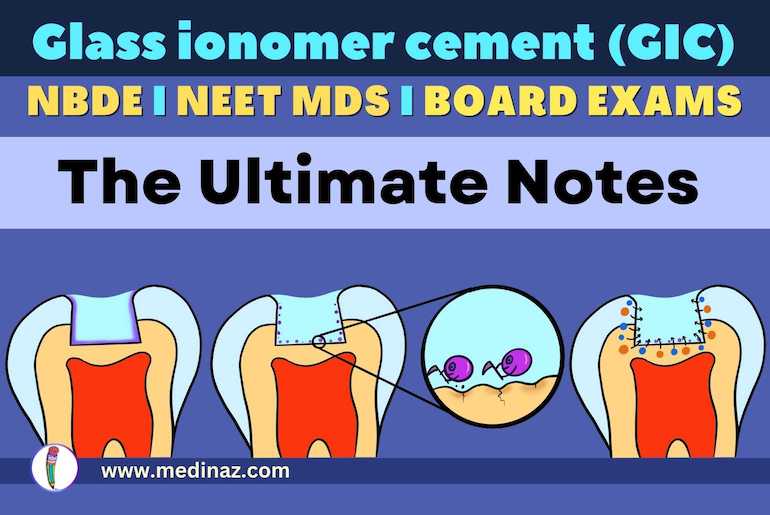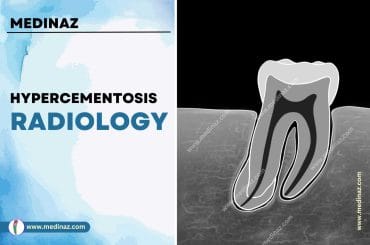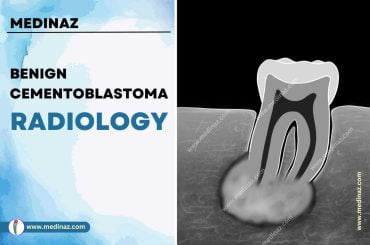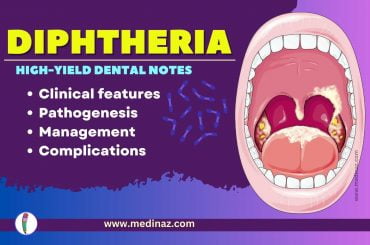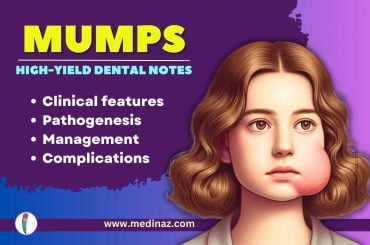This in-depth note covers all the necessary information about Glass Ionomer Cement (GIC)
Table of Contents
Introduction
- ADA no. 66
- 1st GIC was produced in late 1960s by Alan Wilson.
- 1st usable GIC was developed in 1972.
- It did not have appropriate setting time and aesthetics.
- It is called Glass Ionomer because powder is a type of glass:
- Glass: Calcium-aluminosilicate glass; contains calcium-oxide, fluoride, alumina and silica.
- Bond to tooth structure: Ionic bond.
- Requires minimal cavity preparation.
- Biomimetic material.
Glass Ionomer Cement also called
- Alumino silicate poly-alkenoate cement (ASPA)
- Polyalkeoate cement
Glass Ionomer Cement Classification:
Type I – Luting cement
Type II – Restorative cement
Type III – Liner
Type IV – Fissure sealant
Type V – Orthodontic cement
Type VI – Core build up cement
Type VIII Posterior packable GIC for atraumatic restorations
Type IX
Glass Ionomer Cement Application
- Anterior esthetic restoration for class III cavities.
- Restorative material for eroded areas and class V restorations.
- As a luting agent for restorations and orthodontic brackets.
- As liners and bases.
- For core build up.
- Pit and fissure sealants.
- Intermediate restorative material.
**Glass ionomer cements are not recommended for class II and class VI restorations, since they lack fracture toughness and are susceptible to wear.
Glass Ionomer Cement Setting reaction:
- Acid-Base reaction.
- Not exothermic reaction.
- Reaction between Polyacrylic acid (acid) & Aluminosilicate glass (base).
- Setting time:
- Type – I: About 7 mins.
- Type – II: About 4 to 5 mins.
- Powder liquid ratio is 3:1 by weight. Mixing should be done by agate or plastic spatula.
- Setting reaction occurs in four overlapping stages.
Stage – 1: Decomposition of powder
- Upon mixing powder & liquid, the glass in powder will be attacked by the polyalkenoic (polyacrylic) acid in liquid.
- The surface of the glass particles decomposes and releases metal ions (Al3+, Na+, Ca2+ etc.), fluoride and silicic acid (It will later condense into a silica gel that will surround the glass particles).
Stage – 2: Gelation
- As concentration of cations is increased – pH of aqueous phase increases.
- Increased pH of the aqueous phase leads to greater ionization of polyalkenoic acid and create an electrostatic field.
- This electrostatic field aids the migration of the liberated cations into the aqueous phase.
- Now a gel structure is formed through weak ionic cross-links and hydrogen bonds.
Stage – 3: Hardening
- Polymer chains unwind as the negative charge increases, and this leads to an increased viscosity.
- The concentration of cations will continue to increase, and they will condense on to the polyacid chain.
- Formation of cross-links in the polymer chains due to release of metallic ions leads to hardening of the cement.
- Powder dissolution will continue, and insoluble salts will precipitate.
- This initial set will occur within 4 minutes with either a luting cement or a restorative material.
- The final material consists of unreacted glass particles surrounded by the polysalt matrix containing crosslinks.
Stage – 4: Maturation
- Following gelation, the cement will continue to harden and matures as cations are increasingly bound to the polyanion chains and hydration reactions continue.
- Complete maturity and stability takes at least 2 weeks for the fast-setting varieties and about 6 months for the slow-setting, conventional aesthetic cements.
- Set cement: agglomeration of unreacted powder particles surrounded by a silica gel sheath and embedded in a matrix of hydrated calcium and aluminum crosslinked polyacrylic gel.
- Crosslinking of polyacrylic acid chains by calcium ions to form a solid mass – Initial set.
- In next phase Aluminium ions also cross link with polyacrylic acid chains.
- GIC is weak after setting and unstable in water.
- They become stronger and water resistant as reaction progresses.
- Concentration of Aluminium ions is effective in increasing rigidity and stiffness of matrix, due to its ability to bind 3 chains together.
Glass Ionomer Cement Available as:
- Powder/liquid in bottles.
- Pre-proportioned powder/liquid in capsules.
- Light cure system.
- Powder/distilled water (water settable type).
Glass Ionomer Cement Composition:
Powder:
- Silica (SiO2) – 41.9% – Reactive ingredient.
- Alumina – (Al2O3) – 28.6% – Reactive ingredient.
- Aluminium fluoride (AlF3) – 1.6%
- Calcium Fluoride (CaF2) – 15.7%
- Sodium Fluoride (NaF) – 9.3%
- Aluminium Phosphate (AlPO4) – 3.8%
*Fluoride component acts as a ‘ceramic flux’.
* Lanthanum, strontium, barium or zinc oxide provide radiopacity.
Manufacturing powder:
- The components are sintered at 1100°C to 1500°C.
- The glass is then ground to particle sizes ranging from 15 to 50 microns.
Liquid:
- Originally, aqueous solutions of polyacrylic acid (about 40% to 50%) were used, but such liquids were viscous and had a short shelf life because of gelation.
Components:
- Polyacrylic acid copolymer with Itaconic, maleic or tricarboxylic acids – Copolymerizing with iticonic, maleic acid, etc. tends to increase reactivity of the liquid, decrease viscosity and reduce tendency for gelation.
- Tartaric acid – Improves the handling characteristics, increases working time and shortens setting time. Reduces viscosity Improves shelf-life.
- Water – Important component. Reaction medium. Hydrates reaction products.
Water settable cements:
- The polyacrylic acid copolymer is freeze dried and then added to the glass ionomer powder.
- Water is used as liquid.
- Upon mixing 1st the poyacrylic acid dissolves in liquid and then the reaction starts.
Adhesion to tooth structure:
- A diffusion-based adhesion develops between the glass-ionomers and both dentine and enamel.
- This type of adhesion is unique to GIC.
- It binds chemically to polar materials like bone, dentine and enamel.
- Adhesion is divided in 2 stages:
- Free – COOH groups form H-Bonds with the substrate.
- With progression of reaction, the H-bonds are replaced by stronger Ionic bridges.
- An ion-exchange layer is responsible for chemical union between the tooth and GIC.
- Poly(alkenoic acid) attacks and penetrates the tooth structure, displacing phosphate ions.
- Each phosphate ion also removes a calcium ion from the tooth with it.
- These ions are taken up into the cement adjacent to the tooth, leading to formation of an ion-enriched layer that is firmly bound to GIC on one side and both enamel & dentine on the other side.
- Due to polymeric nature of GIC, multiple bonds form between tooth and cement.
- Due to multiple bonds, the breakage of a single bond will not lead to failure of cementation, as the bond can re-form.
- Therefore, though the bond strength appears low, they are quite reliable in clinical conditions.
- Because of the relatively low tensile strength of the glass-ionomer, failure of the union will normally be cohesive within the cement rather than adhesive at the interface between the GIC and the tooth, so that the stronger the cement, the better the adhesion.
Conditioning of tooth surface before placing GIC
- For predictable bond strength between tooth and GIC, the tooth-cement interface should be clear of debris such as saliva, pellicle, plaque, blood and other contaminants
- This is commonly achieved by conditioning the cavity surface with a brief application of 10% poly(acrylic acid). Phosphoric acid (34% to 37%) may also be used.
- Poly(acrylic acid) is a relatively mild acid that dissolves the smear layer within 10–15 seconds, although if left for longer than 20 seconds, it may demineralize remaining dentine & enamel and open up dentinal tubules.
- There are two additional advantages in using poly(acrylic acid) for conditioning dentine:
- Since it is the same acid that is used in GIC, any residue if left behind will not interfere in the setting reaction.
- It modifies the surface tension and therefore enhances the wettability of the tooth surface.
- Conditioning of tooth surface leads to pre-activation of the calcium and phosphate ions in the tooth structure, rendering them more available for ion exchange with GIC.
- In case of Cervical erosion:
- Tooth surface should first be cleaned with a slurry of pumice and water.
- Then the surface is conditioned with 10% poly(acrylic acid) for 10–15 seconds only.
- No cavity preparation is required.
- Since the adhesion is optimal between two smooth surfaces, any instrumentation likely to roughen the tooth surface is strictly contraindicated.
- Instead of removing the smear layer in a prepared cavity, a mineralizing solution such as 25% tannic acid or ferric chloride may be applied.
- Mineralizing solution unites the smear layer to the underlying dentine and enamel and seal over dentinal tubules.
- It is particularly recommended when using GIC as a luting agent for full crowns. Considerable hydraulic pressure may be generated during the seating of crowns, and it is better to seal the tubules rather than open them up prior to placement.
Manipulation of Glass Ionomer Cement
- Powder/Liquid ratio: 3:1 by weight.
- Stiff plastic or metal spatula is recommended.
- Paper pad or cool (retards reaction) dry slab is used for mixing.
- The powder and liquid should be dispensed just before mixing is begun.
- Powder is divided into two or more increments
- The powder should be incorporated rapidly into the liquid.
- Half of the powder is mixed into the liquid for 5 to 15 seconds; the rest of the powder is then quickly added and mixed by folding the cement on itself until a uniform, glossy appearance is achieved.
- The material should not be spread over a large area.
- The mixing time should not exceed 45 seconds.
- A glossy appearance indicates the presence of unreacted polyacid, which is critical for bonding to the tooth.
- A dull appearance indicates that the acid has reacted too much with the glass particles for good bonding.
Mechanical mixing of Glass Ionomer Cement
- Glass ionomers are also supplied as capsules containing pre-proportioned powder and liquid
- A triturator is used to mix the powder and liquid after the seal between the powder and liquid has been broken.
- Capsules are convenient and offer a consistent P/L ratio as compared to hand spatulation.
- The capsule contains a dispensation tip that facilitates direct injection of the mix into the prepared tooth cavity or onto a fixed prosthesis for bonding.
- Requires less mixing time.
- Convenient delivery system.
Cement Placement
- Slightly overfill the cavity with GIC.
- As it is hygroscopic initially (initial set), protect the surface with a plastic matrix for about 5 mins.
- After matrix removal, remove the excess GIC.
- Apply varnish or petrolatum on the surface, so the cement doesn’t dehydrate.
- If the cement is dehydrated it will show crazing or chalky surface.
- Matrix application is not needed with type-I GIC.
- Further finishing if required is done after 24hrs.
Fluoride release
- As with silicate cement, fluoride is used as a flux during the manufacture of the glass powder, and is thus incorporated within the glass, much of it in the form of extremely fine droplets.
- Upon mixing, the surface of powder particles will be dissolved by the poly(alkenoic acid), and there will be a considerable release of free fluoride, although some will remain in the matrix in the form of AlF.
- Initial release is quite high, and decreases rapidly over the next 1 – 2 months, to finally stabilize at a low but steady level.
- As fluoride is not an integral part of the matrix of cement, fluoride release is not deleterious to its physical properties.
- Fluoride ion exchange is possible, and fluoride refills in cement upon external application of fluoride.
- Effects of fluoride release from external surface of filling:
- Fluoride is mildly anti-bacterial so plaque is less likely to accumulate on the surface of the restoration.
- As fluoride is released, calcium and phosphate ions return into the restoration to maintain electrolytic balance, and this leads to maturation and hardening of the cement surface.
- This leads to increased wear resistance of cement over time.
Properties of Glass Ionomer Cement
Biological
- Pulpal response is mild – Greater pulpal reaction than ZOE but less than Zinc phosphate.
- Luting consistency is more hazardous as compared to restorative consistency. Luting cement remains acidic for a longer duration.
- Water settable cements show higher acidity.
- Calcium hydroxide liner should be placed if RDT </= 0.5mm.
- GIC has Anticariogenic property – It release appreciable amounts of fluoride, but the release rate decreases over time.
- Fluoride release is comparable to silicate cements initially.
- Being water-based system, GIC acts as continuing fluoride ion reservoir by taking in Fluoride from different sources and releasing them later-on.
- Reduced marginal leakage due to formation of chemical bonds (prevents secondary caries).
- Bio-active cement – used for Osseo-integration (as bone cement). Promotes bone growth, so it can be used as bone substitute for maxilla-facial surgeries & cement for hip-joint replacement.
Physical properties
- Modulus of Elasticity of GIC is less than zinc phosphate, while its compressive strength is comparable to zinc phosphate – So GIC is susceptible to more elastic deformation. Hence it is less desirable for cementation of all ceramic crown.
- Abrasion resistance is poor as compared to composites.
- Toughness and fracture resistance is poor as compared to resin based composites.
- Compressive strength: type – 1 – 85MPa; type – 2 – 150MPa.
- Tensile strength: Type – 1 – 6.2mpa; Type – 2 – 6.6mpa
Solubility and disintegration:
- The initial solubility is high due to leaching of intermediate products.
- The complete setting reaction takes place in 24 hours; therefore, the cement should be protected from saliva in the mouth during this period.
Adhesion
- Forms chemical bond with enamel and dentine (bonds well).
- Shear bond strength ranges from 3-5 MPa.
- The bonding is due to the reaction between the carboxyl groups of the polyacids and the calcium in the enamel and dentine.
- The bond strength to enamel is always higher than that to dentine, probably due to the greater inorganic content of enamel and its greater homogeneity.
Aesthetics
- inferior to silicates and composites.
- lack translucency
- have a rough surface texture.
- Stain with time.
- restorative GICs are available in different shades.
- Aesthetics are sufficient for restoring cervical lesions and minor defects in non-aesthetic zones.
- luting cement (Type I) is more opaque than the restorative cement (Type II).
Metal modified GIC
- 1st introduced in 1977.
- Made by incorporating metal fillers.
- Intended to improve the strength, fracture toughness and resistance to wear.
- Yet maintaining the potential for adhesion and anticariogenic property.
- The conventional glass ionomer cements have comparable physical properties and far better aesthetics.
- Two types:
- Alloy admixture: Spherical amalgam alloy powder is mixed with restorative GIC powder (Miracle Mix).
- Cermet: Silver particles are bonded to glass particles. This is done by sintering a mixture of the two powders at a high temperature (more grayish and radiopaque).
- These cement systems release appreciable amounts of fluoride, but the release rate decreases over time.
- Less fluoride is released from the cermet.
- Adhesion and fluoride release from the metal-reinforced GICs are very useful for core build-ups.
- Metal-reinforced GICs are of limited in use as an alternative to amalgam or composite for posterior restorations.
Miracle mix
- Spherical Ag-Amalgam alloy powder is physically blended with GIC powder.
- Introduced as amalgam substitute for Hg safety.
- This system also referred to as “Ag-alloy Admix”.
- Flexural strength increased to 40MPa.
- Matrix of cement does not strongly adhere to the silver-tin alloy particles.
- Mainly used for core build-up.
- They are aesthetically poor.
- Have low abrasion resistance.
Cermet
- Contains glass-metal powder sintered to a high density that reacts with PAA to form cement
- Glass power + metal powder –(sintering)– cermet powder.
- Glass & metal powder intimately mixed & compressed at a pressure of >300MPa to form pellets
- These pellets are then fused at 800OC & then ground to a fine powder.
- Commercially available cermet contains approx. 40% Ag-amalgam alloy powder.
- Particle size of alloy is less than 3.5micron.
- Colour is improved by adding 5% Titanium dioxide.
- Better bonding between glass & metal – high abrasion resistance – can be burnished
- Compressive strength – 150MPa
- Tensile strength – 7MPa
- Low fracture toughness
- Coefficient Of Thermal Expansion similar to tooth.
- Shorter Setting Time than conventional GIC
- Can’t be used for anteriors for aesthetic reasons.
- Ideal for preparing a core to receive ceramic or cast crown restoration.
- Restoration of deciduous teeth.
Properties
- Diametral tensile strength of the cement is similar to conventional GIC.
- The fracture toughness of metal modified GIC is similar to that of conventional GIC.
- In the mouth both metal modified and conventional GIC appear to have similar wear rates.
- These cements have short setting times. They can be finished 5 minutes after the start of mix.
- The durability of the cermet ionomer cements as posterior restorative is inferior to conventional glass ionomer cement
- Fluoride release: cermet less than conventional GIC; Miracle mix – more than conventional.
- The strength of either type of metal modified cement (150 MPa) is not greatly improved over that of conventional cement.
- These materials are gray in color because of metallic phases within them; therefore, they are unsuitable for use in anterior teeth.
Resin modified Glass ionomer (RM-GIC)
- Developed in 1980.
- Also called Resin ionomers & hybrid ionomers.
- Developed to overcome some of the drawbacks of conventional GIC like
- Moisture sensitivity
- Low initial strength
- Fixed working times.
- Contain acid base and polymerizable components.
Composition
- Components: fluoro-aluminosilicate glasses, photo-initiators (Camphoroquinone), polyacrylic acid, water, and a water-soluble methacrylate monomer, such as hydroxyethyl methacrylate (HEMA) – may not be grafted onto the polyacrylic acid.
- Essential component of resin modified glass ionomer cements are polycarboxylic (polyacrylic) acid polymer with some pendent methacrylate monomer and free radical initiators.
- The liquid contains methacrylate modified carboxylic acid and water miscible methacrylate monomer, as hydroxyethyl methacrylate (HEMA) or glycerol dimethacrylate (GDMA).
- Some hybrid ionomer cements also contain nonreactive filler particles, which lengthens the working time, improves early strength, and makes the cement less sensitive to moisture during setting.
- Free radical initiators are added to trigger the curing of the methacrylate group.
Setting reaction
- The usual glass ionomer acid base reaction begins on mixing the material.
- This is followed by a free radical polymerization reaction which may be generated by either photoinitiators or by chemical initiators or both.
- If chemical initiators are included, the polymerization reaction will begin on mixing as well.
- The acid-base reaction begins upon mixing and continues after polymerization at a much slower rate than for conventional GICs because less water is present and the reaction is much slower in the solid phase than in the liquid phase.
- Finally, two matrices are formed: Metal polyacrylate salt (Al-polyacrylate) hydrogel and a polymer.
- Initial set of the resin modified glass ionomer cement is the result of the formation of polymer matrix.
- The acid base reaction is essential for its setting as well as the diffusion-based adhesion in addition to the continuing fluoride release.
Variation
- Tri-cure GIC: developed to overcome the limited depth of visible light penetration ability.
- Additional mode of curing apart from light-cure.
- The three curing reaction are: chemically-activated polymerization, light-activated polymerization and an acid-base reaction.
- Chemically activated reaction, as well as the acid base reaction takes place spontaneously when the powder and liquid are mixed
Bonding Mechanism
- Same as that for conventional GICs.
- Higher bond strengths than for conventional GIC, probably due to enhanced micromechanical interlocking to the roughened tooth surface.
- Unfortunately, the polymerization causes shrinkage of hybrid ionomers during setting.
- The lower water and carboxylic acid contents also reduces the ability of the cement to wet tooth substrates, causing more microleakage than with conventional glass ionomers.
Uses
- Restoration of Class I, III or V cavities.
- Bases and liners – Hybrid ionomer serves as a bonding material between tooth and composite – Sandwich technique – recommended for class – II & V composites (moderate to high caries risk).
- Fissure sealants – Low viscosity hybrid ionomers.
- Core build-up.
- As adhesives for orthodontic brackets.
- Cementation of crowns and FDPs.
- Repair of damaged amalgam cores or cusps.
- Retrograde root filling.
SUPPLIED AS
- Chemical cure (acid-base setting reaction of the glass ionomer portion).
- Dual cure (combines acid-base setting reaction of the GIC portion and light curing of the resin portion).
- Tri-cure (combines acid-base setting reaction, chemical and light cured polymerization of the resin portion).
All of them are usually supplied as powder and liquid.
Properties:
- Compressive strength: slightly lower than the conventional GIC – 105MPa
- Diametral tensile strength is greater than conventional GIC – 20MPa
- Hardness: comparable to conventional GIC – 40KHN
- Adhesion: bonding mechanism to tooth structure is similar to that of conventional GIC.
- These materials bond better to composite resins than conventional GIC. Probably due to presence of residual unreacted monomers within the RMGI.
- Microleakage: Greater microleakage compared to GIC. May be due to the polymerization shrinkage and reduced wetting of the tooth by the cement.
- Monomers in hybrid GICs make the cements more translucent.
- longer working time.
- Ability for earlier finishing.
- Better aesthetics
- Enhanced strength characteristics.
- HEMA can cause pulpal inflammation and allergic contact dermatitis. Therefore, hybrid ionomers are not as biocompatible as conventional glass ionomers.
- Dental personnel may be at risk of adverse effects such as contact dermatitis and other immunological responses.
- The temperature increase associated with the polymerization process can also be considered as a drawback of hybrid ionomer cements.
- Not been proven to be superior to the conventional glass ionomer materials with regard to the strength of the adhesive junction, resistance to water up take, fluoride release, solubility and biocompatibility.
- A significant disadvantage of the resin ionomers is the hydrophilic nature of poly hydroxy ethyl methacrylate (polyHEMA), which results in increased water sorption and subsequently its hygroscopic expansion. – initial water sorption has deleterious effects.
- The presence of HEMA in hybrid ionomers increases water absorption and causes expansion of up to about 8% by volume.
- This expansion has been linked to the fracture of all-ceramic crown restorations when used for core build-ups or as luting cements.
COMPOMER
- Compomer is a Polyacid-modified composite.
- Made by incorporating glass particles of GIC in water-free polyacid liquid monomer with appropriate initiator.
- It was made to integrate fluoride-releasing capability of glass ionomers with the durability of resin composites.
Composition & Setting reaction
- Usually single-paste, light-cure material for restorative purpose.
- Powder liquid system are used for luting purpose.
Composition:
One Paste system
- Nonreactive inorganic filler particles
- Reactive silicate glass particles,
- Sodium fluoride, and
- Polyacid-modified monomers, such as a diester of 2-hydroxyl methacrylate with butane carboxylic acid and
- Photo-activators.
Powder liquid system
Powder:
- Strontia-alumina-fluorosilicate glass
- Metallic oxides
- Initiators.
Liquid
- Polymerizable methacrylate / carboxylic monomers.
- Multifunctional acrylate monomers.
- Water.
Material may be chemically cured, light-cured, or dual-cured.
Setting reaction
- Setting of one-component compomers is initiated by photopolymerization of the acidic monomer.
- These are sensitive to moisture.
- Acid-base reaction is slow.
- Like composites, compomers are hydrophobic but to a lesser extent.
- Intraorally they absorb water from saliva, which initiates the acid-base reaction of GIC. This also leads to fluoride release.
- While placing a metal prosthesis: The margin should be light-cured immediately to stabilize the prosthesis.
- The chemical-cure compomers complete their setting reaction in approximately 3 minutes in the oral environment.
- 90 seconds from the end of mixing, when the material reaches a gel state, the excess cement may be removed.
Bonding mechanism
- Require a dentin-bonding agent prior to their placement, as they do not contain water to make them self-adhesive.
- Bond strength of one-paste compomers is similar to or higher than that of RM-GIC.
- Powder-liquid compomer are self-adhesive, because of water in the liquid.
Uses
- Restoration in Low stress-bearing areas such as Class III and V prepared cavity
- Pedodontic restorations.
- Bases
- Luting – Cementing prostheses with a metallic substrate.
- Orthodontic adhesive.
Water sorption
- Water absorption by restorative compomers, is as high as 3.5% by weight.
- It is a desired process to complete the acid-base reaction and subsequent fluoride release.
- Restorative compomer releases less fluoride than conventional GICs and hybrid ionomers.
- Compressive strength decreases with the water uptake.
- When manufacturers treat the reactive glass with silane, water uptake is reduced and strengths are higher.
Clinical performance
- Low Color stability.
- Water absorption and staining by food are likely causes for change in color.
- Compomers perform as well as resin composites for Class I and II restorations and acceptably as luting agents for orthodontic bands.
Advantages
- Fluoride release and anti-cariogenic potential.
Disadvantage
- Lack of adhesion – bonding agents are required.
High viscosity Glass Ionomer Cement
- Originally developed in the early 1990s
- Atraumatic Restorative treatment (ART) was developed for preventive and restorative dental treatment for regions that do not have access to electricity or equipment.
- ART relies on hand instruments for opening tooth cavities, removing carious dentin, and mixing the material.
- Due to inadequate facilities, complete removal of caries might not be possible. In such condition self-adhesive fluoride releasing GIC is natural choice over other restorative materials.
- These GICs contain smaller glass particle sizes and uses a higher P/L ratio.
- They have greater compressive strength.
- They exhibit excellent packability for better handling characteristics.
- They are also used for:
- Core buildups,
- Primary tooth fillings,
- Non-stress-bearing restorations, and
- Intermediate restorations in general practices.
- These materials set faster and are of higher viscosity.
- Finer glass particles, anhydrous polyacrylic acids of high molecular weight.
- The setting reaction is the same as the acid base reaction typical of conventional glass ionomer cements.
- High-viscosity GICs are suitable alternatives to amalgam for Class I and II restorations in primary teeth.
Clinical manipulation
- Steps of ART procedure:
- Isolate the tooth with cotton rolls.
- Access and clean the carious lesion with a hand instrument.
- Remove the soft tissue with an excavator.
- Use a weak acid for tooth conditioning, and
- Place the high-viscosity GIC using finger pressure.
Calcium Aluminate Glass Ionomer Cement
- New in GIC family.
- Also known as Hydraulic cement.
- It has also been recommended as a restorative material.
- It is a Hybrid product of Calcium aluminate and GIC.
- Designed for luting fixed prostheses.
- High-purity Al2O3 and CaO (approximately 1 : 1) are sintered to make calcium aluminate.
- Calcium aluminate is then crushed and milled to a specified particle size distribution.
- When powder (base) mixed with water (weak acid), acid-base reaction begins.
- The reaction leads to formation of hydrates which grow and harden over time.
- This reaction has been paired with glass ionomer ingredients to create the hybrid calcium aluminate GIC.
Composition
Powder
- Calcium aluminate,
- Polyacrylic acid,
- Tartaric acid,
- Strontium-fluoro-alumino-glass, and
- Strontium fluoride.
Liquid
- 99.6% water and
- 0.4% additives for controlling setting.
Function of components
- Glass ionomer components of the cement are responsible for the early properties:
- Viscosity,
- Setting time, and
- Strength.
- The calcium aluminate contributes to:
- Basic pH during curing,
- Reduction in microleakage,
- Excellent biocompatibility, and
- Long-term stability and
- Strength.
- Polyacrylic acid has a dual function in this hybrid material.
- It is cross-linked by Ca2+ ions leached from both the soluble glass and the calcium aluminate.
- Dispersing agent for the calcium aluminate.
Set cement
- Resulting material is a composite of hydrated ceramic material and a cross-linked polyacrylate polymer.
Dispensing
- Capsules: for mechanical mixing.
Properties
- Good Retention, Good shear bond strength and Good compressive strength.
- Working time: 2mins.
- Setting time: 5mins.
- Film thickness: 15 +/- 4 microns.
- Setting expansion: about 0.4% vol. (acceptable expansion).
Check other Medinaz Free Dental Notes
A Visual Learning Platform

